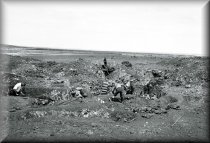There are over 300 naturally occurring manganese (Mn) minerals, but by far the most economically important are the manganese oxides psilomelane, cryptomelane, pyrolusite and wad (manganiferous earth). Traded ores and concentrates normally contain at least 38% manganese. Ninety-eight percent of the world’s output is made into additives for metal industries, mostly the iron and steel industry in which ferro-manganese and silico-manganese additives are used for their sulphur fixing and deoxidising properties. Manganese adds strength and toughness to iron. Another important use is in dry cell batteries, where MnO2 contents of 70–80% are a general requirement. Other uses are as an oxidant in the purification of water, in acid leaching of certain ores (such as uranium), as a colourant in bricks, ceramics and paints, in fertiliser, animal feed and welding rods, and in the manufacture of ferrite and potassium permanganate.
Deposits are generally classified into three major types — chemical sedimentary, residual, and hydrothermal. Manganese-rich sea-bed nodules may become a future significant resource. Australia’s largest production comes from the Groote Eylandt deposit in the Gulf of Carpentaria, Northern Territory. It is a world-class chemical sedimentary deposit with an annual production of ~1.8 Mt, equivalent to 10% of world supply. Most of the ore is exported, with some shipped to Bell Bay in Tasmania for the production of manganese alloys (~200,000 t/year).
World resources of manganese ore are large, but irregularly distributed, and of low-grade. South Africa accounts for ~75% of world resources, and Ukraine for 10%. 2013 world production was 17 Mtonne, with resources estimated at 570 Mtonne.
Total recorded production of manganese ore in South Australia is estimated at 62 000 t, mainly from residual deposits, with half of this coming from Pernatty Lagoon. The last recorded production was in 1951. The only recorded resource is for Pernatty lagoon of 167,500 tonne at 20% Mn.
|
|
| Pernatty Lagoon manganese workings, 1917. |
South Australian deposits
Between 1915 and 1949, the Pernatty Lagoon deposit, 130 km northwest of Port Augusta, produced 34,000 t of ore grading 40–45% Mn from a group of shallow workings on the floor and shore adjacent to an embayment on the western side of the lagoon. Weathering of manganiferous Woocalla Dolomite resulted in development of irregular pods of high-grade manganese mixed with clays. Remaining inferred resources are 152,000 t at 19.6% Mn. Williamson (1988) proposed a formation mechanism of waters containing manganese in solution and suspension upwelling against basement highs with penecontemporaneous deposition of manganese and Woocalla Dolomite. Re-exposure during the Tertiary led to a redissolving and supergene enrichment of manganese and iron.
On eastern Eyre Peninsula manganese deposits are association with banded iron formation and dolomite units of the Hutchison Group. Exploration companies have identified significant drill hole intervals of elevated manganese in the northern Eyre Peninsula (Hercules – Lake Gillies area), and central Eyre Peninsula, Coompana Syncline area of White Flat, Jamieson Tank, and Waddikee areas). Exploration is continuing, with the aim to define JORC compliant resources.
Manganiferous pods occur in haematite deposits of the Middleback Range and appear to be restricted to favourable stratigraphic or structural levels.
Many small supergene manganese oxide deposits occur throughout the Adelaide Geosyncline, generally as near-surface infillings of joints, crush zones, faults and cavities in carbonate rocks, i.e. manganiferous false gossans with no significant depth extent. Several of the more accessible deposits along the western margin of the Flinders Ranges (e.g. Oratunga) have yielded small tonnages. Minor deposits in a similar environment have been tested in shallow pits at Radford Creek, Reaphook Hill, Eregunda, Bungoola, Narina, Wirrealpa and Mount Chambers. Near Moro in Arrowie Gorge, masses of manganiferous ironstone have developed on faulted limestone. Drilling has indicated resources of 300,000 t at 10% Mn and 40% Fe. Small occurrences in Marinoan dolomitic shale in the Carrieton area were mined during World War II. Production from deposits at Coomooroo, Bendleby, Merna Mora, Artipena, Martins Well, Mattawarangula, Springfield, Etna and Ellen Mines totalled 20–30,000 t. Gregory (1988) suggested a chemical sedimentary origin for the Boolcunda deposit, which formed in a favourable shallow marine environment meridionally within the Adelaide Geosyncline. Also the Western Spur prospect in the far Northern Flinders Range, with a lengthy but narrow lode of ferruginous and manganiferous rock identified.
Additional reading
Gregory, C.T., 1988. The geology and origin of sedimentary manganese from the Boolcunda, Etna and Muttabee deposits, central Flinders Ranges, South Australia. University of Adelaide. B.Sc. (Hons) thesis (unpublished).
Johns, R.K., 1971. Mineral occurrences in the Flinders Ranges. Mineral Resources Review, South Australia, 131:11-24.
Williamson, G., 1988. The geology and origin of manganese deposits at Pernatty Lagoon, South Australia. University of Adelaide. B.Sc. (Hons) thesis (unpublished).



